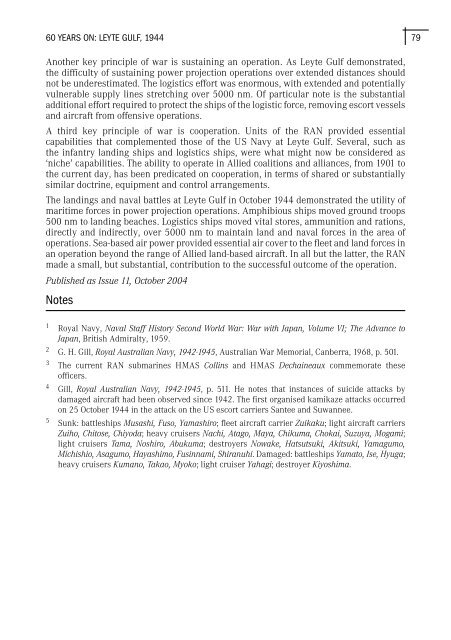Australian Maritime Issues 2005 - Royal Australian Navy
Australian Maritime Issues 2005 - Royal Australian Navy
Australian Maritime Issues 2005 - Royal Australian Navy
You also want an ePaper? Increase the reach of your titles
YUMPU automatically turns print PDFs into web optimized ePapers that Google loves.
60 YEARS ON: LEYTE GULF, 1944<br />
79<br />
Another key principle of war is sustaining an operation. As Leyte Gulf demonstrated,<br />
the difficulty of sustaining power projection operations over extended distances should<br />
not be underestimated. The logistics effort was enormous, with extended and potentially<br />
vulnerable supply lines stretching over 5000 nm. Of particular note is the substantial<br />
additional effort required to protect the ships of the logistic force, removing escort vessels<br />
and aircraft from offensive operations.<br />
A third key principle of war is cooperation. Units of the RAN provided essential<br />
capabilities that complemented those of the US <strong>Navy</strong> at Leyte Gulf. Several, such as<br />
the infantry landing ships and logistics ships, were what might now be considered as<br />
‘niche’ capabilities. The ability to operate in Allied coalitions and alliances, from 1901 to<br />
the current day, has been predicated on cooperation, in terms of shared or substantially<br />
similar doctrine, equipment and control arrangements.<br />
The landings and naval battles at Leyte Gulf in October 1944 demonstrated the utility of<br />
maritime forces in power projection operations. Amphibious ships moved ground troops<br />
500 nm to landing beaches. Logistics ships moved vital stores, ammunition and rations,<br />
directly and indirectly, over 5000 nm to maintain land and naval forces in the area of<br />
operations. Sea-based air power provided essential air cover to the fleet and land forces in<br />
an operation beyond the range of Allied land-based aircraft. In all but the latter, the RAN<br />
made a small, but substantial, contribution to the successful outcome of the operation.<br />
Published as Issue 11, October 2004<br />
Notes<br />
1 <strong>Royal</strong> <strong>Navy</strong>, Naval Staff History Second World War: War with Japan, Volume VI; The Advance to<br />
Japan, British Admiralty, 1959.<br />
2 G. H. Gill, <strong>Royal</strong> <strong>Australian</strong> <strong>Navy</strong>, 1942-1945, <strong>Australian</strong> War Memorial, Canberra, 1968, p. 501.<br />
3 The current RAN submarines HMAS Collins and HMAS Dechaineaux commemorate these<br />
officers.<br />
4 Gill, <strong>Royal</strong> <strong>Australian</strong> <strong>Navy</strong>, 1942-1945, p. 511. He notes that instances of suicide attacks by<br />
damaged aircraft had been observed since 1942. The first organised kamikaze attacks occurred<br />
on 25 October 1944 in the attack on the US escort carriers Santee and Suwannee.<br />
5 Sunk: battleships Musashi, Fuso, Yamashiro; fleet aircraft carrier Zuikaku; light aircraft carriers<br />
Zuiho, Chitose, Chiyoda; heavy cruisers Nachi, Atago, Maya, Chikuma, Chokai, Suzuya, Mogami;<br />
light cruisers Tama, Noshiro, Abukuma; destroyers Nowake, Hatsutsuki, Akitsuki, Yamagumo,<br />
Michishio, Asagumo, Hayashimo, Fusinnami, Shiranuhi. Damaged: battleships Yamato, Ise, Hyuga;<br />
heavy cruisers Kumano, Takao, Myoko; light cruiser Yahagi; destroyer Kiyoshima.

















